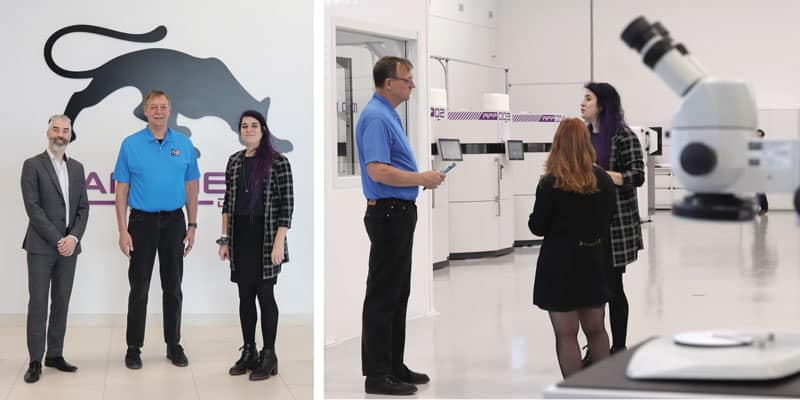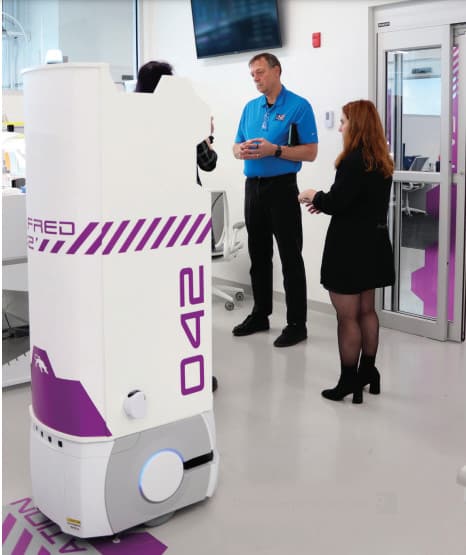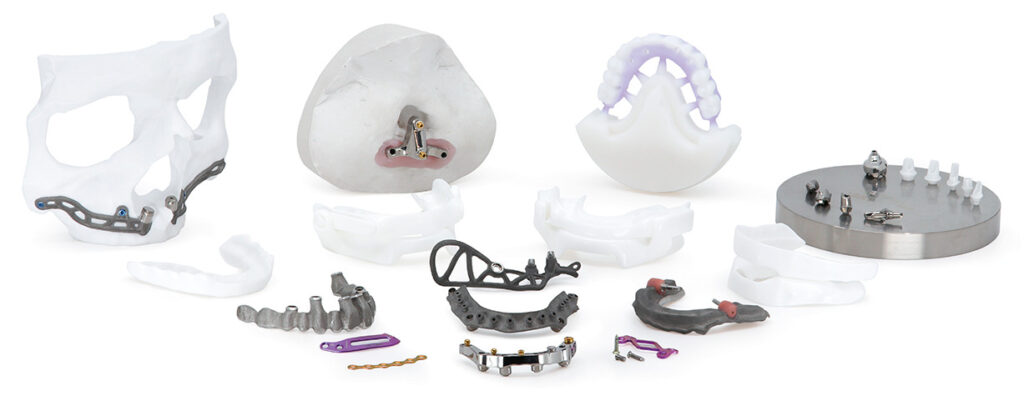Panthera Dental is defined by innovative processes and efficient use of resources.
 by Steve Carstensen, DDS, FAGD, FACD, FICD, D.ABDSM
by Steve Carstensen, DDS, FAGD, FACD, FICD, D.ABDSM
Dentistry, even sleep breathing dentistry, is an artist’s medium. Sculpting teeth and making bespoke devices, whether in the mouth, lab bench, or CAD program, is the expression of the artistic skills of the creators. Individual creativity is what we all treasure in the visual, performing, and creative arts. Dentistry is healthcare – and, in our field, millions of people breathe poorly and need our help. Can they all be served by the artists?
Manufacturing is entering a new phase – in history, there have been four major shifts. The first change was external power replacing human work, the second, mechanical assembly lines and the third, the entry of computers to the creative process. Phase 4.0 is when the machines, using AI, connect with each other to maximize productivity and efficiency. Additive manufacturing, or 3D printing, allows nuanced details such as complex dental anatomy to be fully considered. Human designers individualize care while robotic manufacturing provides the ability to scale to meet population health needs. Artistry meets innovation meets manufacturing.

The first automobiles were built by hand by their inventors. Demand soon resulted in builders coming together to put the machines together, by hand, one at a time. It wasn’t until Henry Ford created the moving assembly line that enough cars could be produced to meet the needs of the population. Today’s F150 is put together with up-to-date versions of that same assembly line – lots of people plus one robot to place the windshield glass. Tesla reinvented the assembly line, using 160 robots linked to purpose-built software. Onsite engineers and computer programmers can change anything nearly immediately. Ford uses Phase 2 manufacturing with enhancements; Tesla, and now Panthera Dental, are working in Phase 4 industries.
Back to dental devices to maintain an open airway – begun by entrepreneur dentists in their own offices, soon embraced by dental restorative laboratories. More recently, we’ve seen the third industrial phase introduced. Manufacturers are using CAD design, 3D printing, and CAM – computer milling machines to create custom devices out of raw materials. Humans apply design talents and send instructions to the machines, one by one. Increasing efficiency requires more humans, more skills, and more machines. A faster assembly line.

Can this thinking provide the answer to millions of patients who need a dental device? We are witnessing a CPAP recall, the rise of consumer sleep technology and the lowering of barriers to diagnosis and medical decision making around sleep related breathing disorders. A tsunami of demand for dentist-driven oral appliance therapy is at hand. Is the industry ready to meet a sudden need for tens, hundreds, of thousands of oral appliances?
Panthera Dental’s Robichaud family leaders are visionaries. Spinning up the traditional assembly process to be ready to make more devices was too small. After all, it was this family who developed the world’s first CAD-CAM oral appliance, implant bar, and maxillofacial prosthesis. They wrote the very first software that made 3D printed nylon devices possible. A version of that program is still in use today in France. After their previous company BioCAD was acquired by Nobel BioCare, who is not present in the sleep appliance space, the family formed Panthera Dental, and built from the ground up a suite of new generation software dedicated to implants, prosthetic and sleep. Today the company is run with many of the same early team, including the software engineer who wrote the first ever sleep CAD-CAM code and the lab artist who originally made sleep appliances by hand. Today’s 3D print engine is the result of decades of experience and is entirely contained in the same network that runs Panthera. Bug fixes, upgrades, and innovations are done daily by the engineers working only steps away from the production floor.
A tsunami of demand for OAT is at hand.
Not a production floor like you might think of. When Tesla bought an old car factory, they installed skylights and painted the floor with white enamel to emphasize light and cleanliness. Two years ago, Panthera’s third production facility opened to incorporate every innovation to enhance outcome detail, the importance of work-life balance in the team, and 4.0 manufacturing. When milling an implant bar from a puck of titanium, or using a world-class 3D printer to create titanium maxillofacial custom implants and prosthesis, tolerances are in the single-digit microns. Keeping those promised fit standards was part of building design – the floors are three times the thickness code requires, just to make sure traffic vibrations don’t disturb the milling robots and lose precision. Besides the metal structures, Panthera makes more than the DSAD Classic and DSAD X3 mandibular advancement devices – they are soon to be joined by some innovative oral orthotic designs being tested. Meeting patient needs via dentist-customer ideas.
Manufacturing 4.0 also requires efficient use of expensive resources. Dental devices are printed using laser-sintered Polyamide 12 – a standard medical-grade nylon material, in batches of dozens at a time – but there’s no waiting to ‘fill the machine’ if that would hold up delivery to the patient breathing badly. Panthera’s software uses artificial intelligence to track every case from order to delivery date, placing it in front of the expert designer, sending the code to the right printer, and guiding the QC department for which order comes next. Even shipping is directed to reduce delivery times. Machines are interconnected and signal the humans responsible at each step to create efficiencies. Any need to move faster can be driven by the AI – not a faster production line, but simply upscaled versions of what happens every day at Panthera. Work trays are distributed around the facility not by people struggling to open doors with armloads of cases, but by Alfred, a fully autonomous mobile robot. He glides on his electronic rounds, avoiding people and obstacles, like your Roomba with shelves. Efficient, and fun! More machines can easily be brought online, more designers trained because everything is in-house. The AI even helps plan for production peaks and valleys – no team member is going to face an unmanageable workload, unwanted overtime, and an unexpected interference with their home life.

The culture of Panthera grows from Robichaud family values. Current leadership, co-founder siblings Gabriel and Beatrice Robichaud, along with their aunt Diane, understand the value of coworkers feeling supported. Instead of hiring out a customer service group, or even placing the people answering the phone offsite somewhere, when a dentist calls in, the person taking the call is a short walk to the production floor, the designer, the software engineer, accounting, and the CEO’s office. Every team member has free reign to bring an issue up wherever it might need to go. Large displays show real-time production queue, quality measures, customer location and other company data, connected, yes, to the same software network. The new building’s brightest, most window-filled space is the team lunchroom – long community tables for maintaining connectedness. A (very) big screen TV provides entertainment – during a Stanley Cup match people came back to the office to cheer their team on together. Does that happen at your dental clinic? Imagine the shared commitment to best practices when everyone on the team feels connected. It’s not just the machines sharing a network in 4.0 manufacturing.
Choose to be ready for this bright future.
There are many reasons to pick where the order for the MAD ends up, but increasingly, shared values are becoming important factors for dentist’s choices. Supporting a company that is committed to a smaller environmental impact, a happier, values-driven culture, and a future focus provides the dentist more than a ‘bottom line’ justification for choosing one device over another. In the dental office, efficiency means an excellent fit and long service life – good value for the patient.

Precision and correctness of fit, not synonymous terms, are hallmarks of the careful process at Panthera. Each device is custom designed, efficiently, by the software developed by Panthera engineers. The amount of retention, the fit around each tooth, even the placement of the components are all customized under the trained eye of the CAD artist. The nimble software can meet the needs of most patients and their dentists. Additive manufacturing can be adapted to more details of the oral anatomy with less waste than milling or hand-building devices. Panthera has a process for every level of expertise and equipment choice, from stone models to highly sophisticated intraoral scans. One of their early adopters is a dentist who now heads up R&D, putting innovation into real practice with over 2,500 nylon devices delivered. Working with the armed forces of both Canada and the US has further refined what can be done when everyone on the team shares commitment to highest quality, cutting edge innovation, and maximizing 4.0 manufacturing.

Dentists as artist-scientists. Together with supplier-artists using 4.0 manufacturing, we are the ones who will finally help large numbers of people make every breath, every night, their best. Panthera Dental has made the choice to be ready for this bright future. Choose wisely, and you can be, too.
Panthera Dental strives to provide a range of customization options for all types of patients. Read more about the company here: https://dentalsleeppractice.com/a-success-story/


